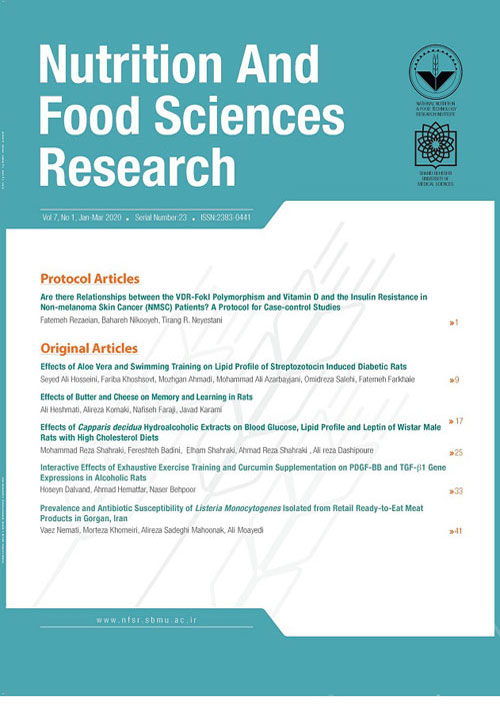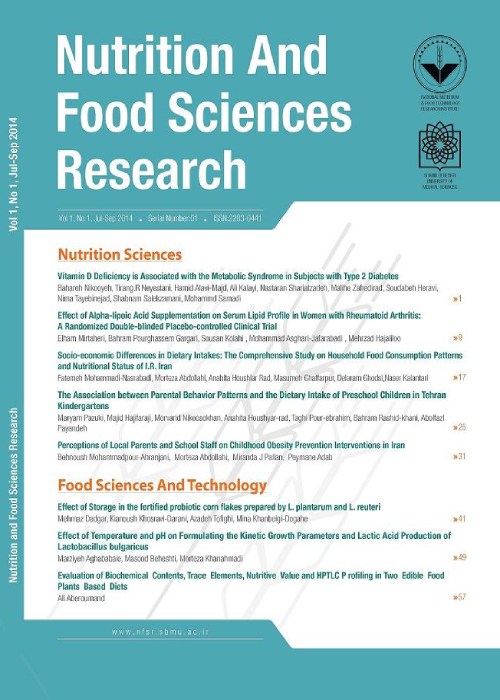فهرست مطالب

Nutrition & Food Technology Research
Volume:7 Issue: 4, Oct Dec 2020
- تاریخ انتشار: 1399/08/18
- تعداد عناوین: 6
-
-
Pages 1-6
The aim of the current study was to investigate frequencies of interactional metadiscourse markers in English academic research and popular science articles in nutrition. A total of 60 English articles published in three popular databases and four academic journals were analyzed for interactional metadiscourse markers, including hedges, boosters, attitude markers, engagement markers and self-mentions. Results of the analysis revealed nearly twice as many interactional metadiscourse markers in the academic research articles, indicating a higher level of explicit interaction in that genre. Results of the chi-square test (p ≤ 0.01) demonstrated that uses of metadiscourse markers differed significantly in the two genres. Findings showed that the authors of academic research and popular science articles tried to create balances between highlighting the significance and pinpointing the tentativeness of the claims and, thereby, they made interactive choices to approximate their readers’ world. Furthermore, results highlighted the high relevance of popular science articles to academic research articles since authors were inevitably involved in transforming and recovering scientific findings into more comprehensive accounts in popular science texts. Findings can be transferred to pedagogical grounds through raising students’ awareness in English writing courses about the way; through which, the authors of academic research and popular science articles use interactional resources to enhance quality and efficiency of their interactions with the readers.
Keywords: Academic research articles, Interactional metadiscourse, Nutrition, Popular science articles -
Pages 7-12Background and Objectives
Children malnutrition is a serious problem worldwide, especially in developing countries. The present study designed to investigate nutritional statuses and their associated risk factors in school-going children in Bangladesh.
Materials and MethodsThis study included 650 children (391 boys and 249 girls) aged 5–13 years old, living in the rural area of northern Bangladesh. Anthropometric measurement was carried out to measure the nutritional statuses of the participants. The participants were asked for their dietary history. Food frequency questionnaire was used to collect dietary intake information. All participants were interviewed about their personal characteristics and health conditions. All information were recorded in questionnaires.
ResultsResult of the study raveled that nutritional status of 37.53% of the participants were good and the rest were malnourished. Results demonstrated dominant underweight (boys, 50.38% and girls, 63.85%), wasting (42.19% of boys and 67.46% of girls) and stunting (boys, 47.05% girls, 77.51 %.) within the participants. Furthermore, study raveled that educational levels of the parents were low that might affect dietary intakes of the children and result in high prevalence of malnutrition in the studied area.
ConclusionsIt is concluded that the parents’ educational levels were highly important for the nutritional statuses of the children. Girls were more malnourished than boys in this study. This study have suggested further assessment of the socioeconomic statuses of the households in relation to children malnutrition.
Keywords: Children, Education, Nutrition, Malnutrition, Underweight, Stunting, Wasting -
Pages 13-18Background and Objectives
Dietary diversity is a proxy measurement of overall dietary quality. The aim of this study was to assess relationships between dietary diversity score and obesity phenotypes in women, Tehran, Iran.
Materials and MethodsIn this cross-sectional study, 197 women aged ≥ 25 years from Municipal District 7 of Tehran were participated. Food intakes were calculated using semi-quantitative food frequency questionnaires. Dietary diversity score was calculated using healthy food diversity score. Anthropometric parameters and physical activities were measured based on the standard methods. Multivariate logistic regression was used to show possible associations between the dietary diversity scores and the obesity phenotypes.
ResultsThe mean (±standard deviation) age of the participants was 37.0 y ±7.41. The mean weight, body mass index, waist circumference, waist-to-hip ratio and waist-to-height ratio were 78.3 kg ±1.2, 27.1 kg/m2 ±34, 92.5 cm ±14.4, 0.87 ±23.4 and 0.57 ±6.97; respectively. The mean (±SD) of dietary diversity score was 0.27 ±16.73. No relationships were seen between the dietary diversity scores and general obesity, high waist-to-hip ratios and waist-to-height ratios. However, risks of high waist circumferences decreased with increasing dietary diversity score ]OR(CI): 0.26 (0.09–0.75); p-trend = 0.04[.
ConclusionsIn conclusion, inverse relationships were seen between the abdominal obesity and the dietary diversity scores in women in Tehran. Therefore, more various diets are recommended for the prevention of obesity in women.
Keywords: Dietary diversity score, Abdominal obesity, Overweight, women, Iran -
Pages 19-26Background and Objectives
Increased public knowledge concerning roles of nutrition in prevention of non-communicable diseases have urged people to select healthy foods. The aim of this study was to investigate levels of understanding and use of food labeling systems and their determinants by medical students of Tabriz University of Medical Sciences, Tabriz, Iran.
Materials and MethodsIn a cross-sectional study on medical students of Tabriz University of Medical Sciences, 2018, 240 medical students were participated using stratified random sampling method. During the study, participants were asked about their use of nutritional value panel, ingredient list and serving size information of the food labels. To assess understanding levels of the food labeling, subjective and objective methods were used.
ResultsBased on the findings, 41.2% of the participants always/most often read food labels when purchasing foods, while 34.2% of them read food labels occasionally. The most common reason for non-using food labels included lack of time to read the food labels (40.8%). A relative majority of the participants (42.5%) occasionally used food labels for diet planning. A majority of the participants (74.6%) reported that they somewhat were aware of food label information. Moreover, 70 to 90.4% of the participants chose the right label as the healthiest from three pairs of labels. Understanding and use of food labels were higher in females than males (p = 0.046 and p = 0.038, respectively).
ConclusionsLess than half of the medical students always/most often used food label information when buying food products. Further studies on other populations are needed to suggest recommendations for an effectual food labelling.
Keywords: Medical student, Understanding, Using, Food label -
Pages 27-32Background and Objectives
Medicinal pastilles are soft candies made (solidified) of thick liquids containing medicinal active ingredients. Licorice and its extracts are within the most important herbal plants used in various food industries and confectionaries. The substance is effective against diseases such as bronchitis and gastric ulcers.
Materials and MethodsIn this study, effects of agar as a hydrocolloid and major active constituent of licorice (glycyrrhetinic acid) were studied on sensory attributes, texture properties and color indicators of fruit pastilles. Agar at three levels of 1, 2 and 3% and glycyrrhetinic acid at three levels of 0.1, 0.5 and 1% were used. Sensory attributes (taste, odor, firmness, elasticity, degree of adhesion and total acceptance), texture properties (stiffness, cohesiveness, gumminess and chewiness) and color indicators (L* a* b*) were assessed.
ResultsResults showed that with increasing agar, brightness, redness and yellowness of the samples increased. By increasing agar, stiffness, cohesiveness, gumminess and chewiness of the samples increased as well. Organoleptic results showed that sensory properties of the samples were satisfying. Samples containing 3% agar and 1% glycyrrhetinic acid included the highest stiffness (18555.5 N/m), cohesiveness (0.48), gumminess (7.6 N) and chewiness (0.026 Nm). Pastilles with 2% agar and 0.5% glycyrrhizin acid were the best products. Their stiffness, cohesiveness, chewiness and gumminess were minimal with good color and sensory properties.
ConclusionsWith the production of these pastilles, it is possible to use the unique properties of licorice.
Keywords: Glycyrrhetinic acid, Medicinal pastilles, Texture properties, Sensory characteristics -
Pages 33-39Background and Objectives
Onion (Allium cepa L.) possesses aromas and flavours, which have made them one of important ingredients of food. In addition, recent publications have reported that onion and its extract have many biological properties such as antimicrobial and antioxidant. Yellow and White Sweet Spanish onions belonging to Amaryllidaceae, are cultivated all over Iran as a condiment, vegetable, and medicinal herbs. In present study, the antioxidant and antimicrobial properties of outer and inner layers were investigated in two hybrid onion bulbs; Yellow and White Sweet Spanish.
Materials and MethodsCultivation of plant material consisting two cultivars was performed in Isfahan experimental farm 32°38′27.6″N, 51°46′50.3″E, Iran. In order to assess of sample antioxidant capacity, total phenolic, and total flavonoid contents were estimated for the various fractions. In vitro antioxidant potential of scales onion extracts was evaluated using the scavenging activity for DPPH. Furthermore, this extract was investigated for its ability to provide protection from DNA damage. Disk diffusion and micro-well dilution as some antimicrobial properties of phytochemicals extracted from onion layers were evaluated against seven bacteria and four fungi.
ResultsEvaluation results of onion extract biological properties showed that aqueous extract of outer layer had the highest antioxidant activity comparison inner layers. However, extract from Yellow Sweet Spanish onion had more phenolic, flavonoid, radical scavenging activities on DPPH. Thereupon, aqueous extract from outer layers of Yellow Sweet Spanish extract showed the most ability to protection against DNA damage caused by reactive oxygen species. Extracts of inner layers of Yellow Sweet Spanish had more inhibition zone and lower MIC and MMC, for all microorganisms.
ConclusionsThis study showed that aqueous extract of outer and inner layers of both onion lumps (Yellow and White Sweet Spanish) had antioxidant activity and inner layers of extract had antimicrobial activity. It should be noted that extract of outer layer onions had the highest antioxidant properties but no antimicrobial properties. Therefore, the aqueous extract of Yellow and White Sweet Spanish onions might be a valuable food additive and can be used as natural antimicrobial and antioxidant additives for incorporating in various food products.
Keywords: Free radical, Medicinal herb, Onion bulb, Pharmacological properties


